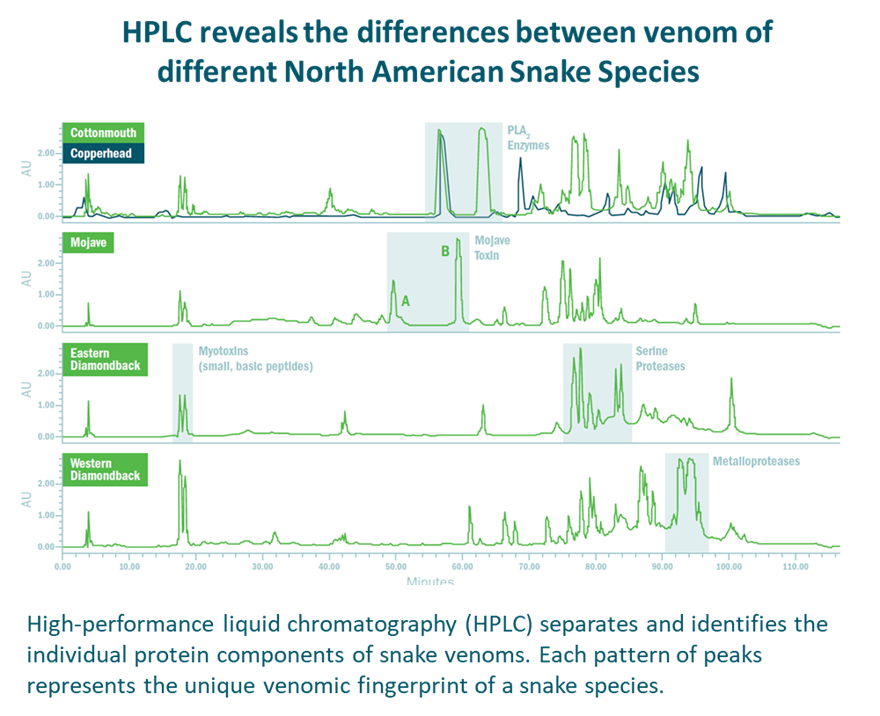We’re sometimes asked: How can one antivenom effectively treat bites from several types of venomous snakes? The answer, in short, is venomics, the scientific analysis of venom.
Venom is a notoriously complex and ever-evolving mix of bioactive proteins and peptides. The science of “venomics” aims to better understand the composition of venom using techniques such as high-performance liquid chromatography (HPLC). Each snake has a unique “venomic fingerprint” influenced not only by species, but diet, climate, geography, age, sex, and health of the snake. That’s why the World Health Organization (WHO) guidelines state that the ideal and most effective antivenom should be derived from snakes that are representative of the snake population living in the area where the antivenom is being used.
Venomics has become an important tool in the design and evaluation of antivenoms. To create our antivenom for North American pit vipers, we began by separating and identifying the individual protein components of snake species native to the US. These venoms contain toxins that cause tissue damage, changes to the blood, and neurotoxic effects. A better understanding of venom components allowed us to select a cross-section of four different snakes reflective of the diversity of venom composition throughout the US.
For example, one of the species included in our process, the cottonmouth, was chosen for its abundance of Phospholipase A2. Countering this component of snake venom helps our antivenom offer broad cross-species coverage for various venom compositions, including the copperhead snake, which accounts for 50% of north American pit viper envenomation.

Designing effective antivenom isn’t the only thing venomics is good for. In recent years, scientists have begun to explore its potential to create medicines that treat everything from cancer to high blood pressure, chronic pain and more.
The promise of venom-as-medicine: from ancient Greece to 2020
Over 2,000 years ago, the historian Appian of Alexandria reported that upon receiving a sword wound to the leg, Scythian doctors saved his life with “a small amount of steppe viper venom” that they used to stop the bleeding. Snake venom has been used in Ayurvedic medicine since the 7th century BCE to treat arthritis and gastrointestinal ailments, while tarantulas are used in the traditional medicine of indigenous populations of Mexico and Central and South America.
Modern medicine, however, has struggled to make use of these toxins. Even though 15% of the world’s animal population produces venom of some kind, only six drugs derived from venom are approved for use by the FDA.
Fortunately, that’s beginning to change. Historically, studying the potential uses of venom was difficult because they contain such a sophisticated cocktail of components, which are often difficult and dangerous to extract – but now, as Medical News Today explains, “advances in omics — the identification and quantification of biological molecules that make up an organism — are providing deeper insight.”
In other words, with much of the DNA and RNA of the venom already identified, researchers can more easily “synthesize its components and test out its theories.”
A 2018 paper highlighted, for instance, the potential for the deathstalker scorpion to help call attention to tumor cells before surgery to ensure all cancerous tissue is removed; for sea anemones’ peptides to help treat autoimmune diseases; and for a species of venomous sea snails to provide non-addictive chronic pain relief.
As Mandë Holford, the lead author of the study, put it: “I like to describe venom as a cluster bomb. Its job is to shut down the normal function of the prey and in doing so, it fans out (and) hits several targets, which is a great thing for pharmaceutical development because you have several avenues to explore.”
While the budding potential of venomics remains to be wholly realized, it’s clear that such research will continue to play a vital role in medicine – be it in developing effective, broad-coverage antivenoms, or a range of new life-saving medicines.
HOW ANTIVENOM WORKS
Watch this video to learn how antivenom works and why we have selected the four species of snake used in our process.
Read more

